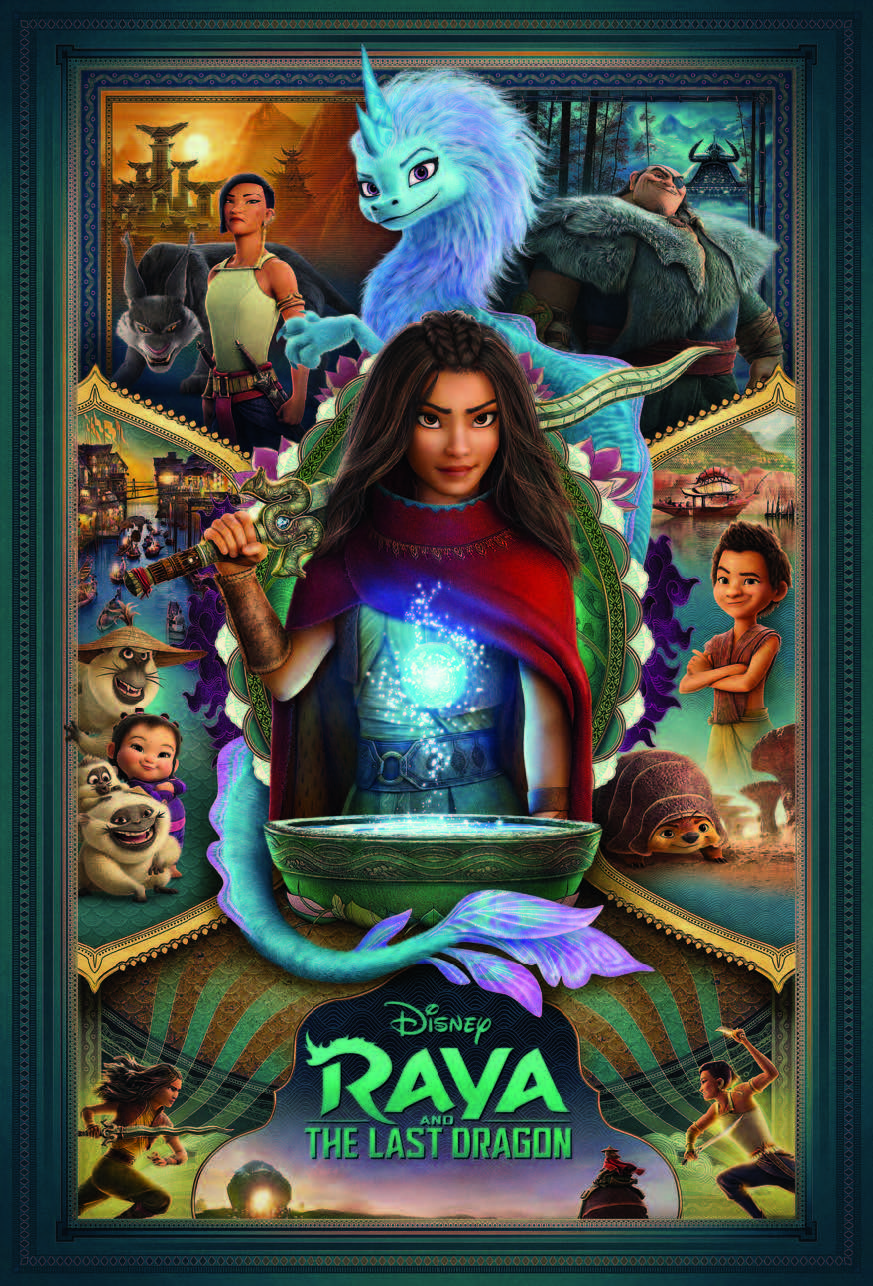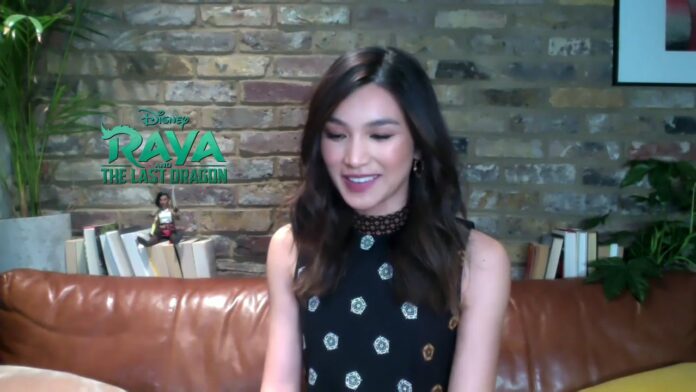Raya’s journey in “Raya and the Last Dragon” takes her through the five lands of Kumandra, a fantasy world that forms the shape of a dragon: Heart, Raya’s home, a prosperous land filled with peace and magic; Fang, a powerful, thriving land surrounded by water; Spine, an insular and remote land whose people distrust outsiders; Talon, the crossroads of the five lands and a bustling marketplace; and Tail, a far-flung desert land that is becoming more isolated as water recedes.

The five lands of Kumandra are distinct and filled with their own unique cultures and creatures. To fill this fantasy world, the Crowds Animation department animated more than 72,000 individual elements, including 18,987 human characters and 35,749 non-human characters. The scene with the largest number of animated characters takes place underwater and features 23,836 animated fish.
Each land in Kumandra has its own physical characteristics and each clan its own ethos, so in essence filmmakers were creating five completely different environments with varying structures and topography, each filled with people who were clothed differently and styled differently. “We have a world made up of five different lands,” explains producer Osnat Shurer. “That’s like designing five movies. They have five different natural environments, materials they build with, different colors the locals wear, different shape languages that are meaningful to them. For example, in the land of Heart, they are connected to the dragon and the dragon is connected to water, so buildings, rooms, etc., look more like a drop—they’re round. Whereas in the land of Fang, they’re all about power, so the structures are powerful and over-scale. Every one of these things have been thought through by our incredible visual development and production design team members and then carried through into the film.”
Two groups of filmmakers made research trips throughout Southeast Asia—including Laos, Indonesia, Thailand, Vietnam, Cambodia, Malaysia and Singapore. The research trips became a profound experience for those within the team who had never visited Southeast Asia in such an immersive way.
As director López Estrada explains, “We’re making a movie that is inspired by the cultures of Southeast Asia, and we want to make sure that when people from the region see this, although Kumandra is a made-up place, they can feel the love and respect the team had for the incredible real places that inspired us. We worked hard to make sure that this world we created feels dynamic, that the inspirations affecting the story really come through and that nothing is lost. We want to pay tribute to these cultures that inspired the story and the world of Kumandra.”
Production designer Paul Felix was impressed not only by the architecture, colors and designs of the places he visited, but by how meaning and aesthetics are woven into all aspects of life. One of the elements that had a deep impact on all the filmmakers was the role food played across all the regions they visited, and though there were both similarities and differences in the tastes and the way the food was prepared along the way, the importance of food in the whole region was inspiring. As each land has its own identity as a people, the production designers assigned very strong color palettes to each of them. For instance, Fang has a golden beige with strong accents of black and red in it, and Tail, the desert land, has mustard colors and more natural dusty colors.
Costume Design
Inspired by garments found throughout the cultures of Southeast Asia, the costumes in “Raya and the Last Dragon” used draping-based designs rather than the pattern-based designs used in previous films. Functionality was a key aspect of the costume design, so the teams created breathable draping styles inspired by the sabai top and sompot pant found in Laos, Cambodia and Thailand. Numerous fabrics were used to create the distinct styles found in each of the five lands of Kumandra. In addition to cottons, linens and leathers, 10 different varieties of rich, woven silk and brocade were used—many patterned in a style inspired by the Indonesian technique of batik.
Raya’s hat features dragon-scale detail and rises to a peak shape as an homage to the stupas found on temple grounds throughout Southeast Asia. Lao visual anthropologist Dr. Arounsack, who consulted on the hat’s design, explains, “There were two critical aspects behind the inspiration for the hat. One is that we took an elemental approach, so if you look at the base of the stupa, the base of the stupa signifies the earth, and as it goes into the dome shape, the dome itself signifies water, so much of the hat is anchored in the importance of the interplay and the relationship between the earth and the water. We thought that fit well within the themes of the movie. Another part of it is that, when we looked at the shape of the hat, it represents a journey—a journey that tapers and finds its way into an apex of wisdom and clarity.”
Martial Arts
The complex fighting styles employed by Raya and Benja, from the land of Heart, are inspired by Malaysian and Filipino martial arts. When armed, they utilize Arnis, a Filipino fighting style that emphasizes intricate weapon forms (including escrima, which Young Raya wields at the top of the film). Unarmed, they fight using Pencak Silat, a Malaysian and Indonesian fighting style that incorporates animal stances and intricate defenses and strikes.
If Heart’s fighting styles are elaborate and dynamic, the fighting techniques of Fang (the land where Namaari comes from) work perfectly in opposition. Her style centers on power and strength. When unarmed, her punches, elbow strikes and kicks are inspired by Muay Thai (also Kun Khmer and Muay Lao), the powerfully effective kickboxing techniques of Southeast Asia. She hits, strikes and kicks hard. But that’s not the only thing in her arsenal—she also displays a Vietnamese form that uses surprising flying-scissor-leg takedowns as her means of grappling. When armed, Namaari fights using Krabi Krabong, a Thai sword-fighting style that (like Muay Thai) emphasizes powerful slashes and cuts for both defense and offense.
KELLY MARIE TRAN (voice of Raya) Most recently, Tran voiced Dawn in DreamWorks’ “The Croods: A New Age,” the sequel to the Oscar®-nominated animated feature about a caveman family. In 2017 Tran made her big-screen debut in “Star Wars: The Last Jedi” as Resistance mechanic worker Rose Tico.
AWKWAFINA (voice of Sisu) is a Golden Globe®–winning actress, writer and producer from Queens, New York. She grew up with her given name, Nora Lum, and has since used her trademark comedic style and signature flair to become a breakout talent in the entertainment industry. Lum brings an impressive range of talent to everything she does, most famously to Warner Bros.’ smash hit “Crazy Rich Asians,” opposite Constance Wu, Michelle Yeoh, Henry Golding and Ken Jeong, in which she starred as Peik Lin.
GEMMA CHAN’s (voice of Namaari). Chan starred as Astrid in the Warner Bros. film adaptation of Kevin Kwan’s best-selling novel “Crazy Rich Asians.” Chan has just been announced as L’Oréal Paris’ latest international spokesperson and is a UNICEF UK ambassador.
Walt Disney Animation Studios’ epic adventure Raya and the Last Dragon arrives on all major digital platforms beginning April 2, and on 4K Ultra HD™, Blu-ray™ and DVD beginning May 18.
Walt Disney Animation Studios’ Raya and the Last Dragon Bonus Features*
- An Introduction to Us Again – Director Zach Parrish takes you behind the scenes of the Walt Disney Animation Studios short.
- Us Again – An elderly man and his young-at-heart wife rekindle their passion for life on one magical night.
- Taste of Raya – Dine along with Kelly Marie Tran and the film’s creative team–virtually–over a Southeast Asian menu inspired by the countries that influenced the film as they discuss their experiences creating the world of Kumandra.
- Raya: Bringing it Home – When the global pandemic of 2020 hit, production of Raya and the Last Dragon moved to the houses of over 450 people. We open a window into their lives and learn how they overcame massive obstacles to make an animated feature from home.
- Martial Artists – You’ll get a kick out of learning about the martial art forms and weapons used in the film as co-screenwriter Qui Nguyen and visual anthropologist Dr. S. Steve Arounsack share the inspiration behind the film’s action-packed elements.
- We are Kumandra – Meet members of the Southeast Asia Story Trust and discover the cultural influences that inspired the film…and how important this representation in a Disney animated film is to the people of the region.
- Outtakes – Step into the homes and behind the mics of the cast of Raya and the Last Dragon as they experience voice-over sessions in closets and shaky internet connections, which made recording this film unlike any other.
- Fun Facts & Easter Eggs – Take a look at some of the hidden surprises and behind-the-scenes secrets of Raya and the Last Dragon.
- The Story Behind the Storyboard with John Ripa – Co-Director John Ripa invites you to get an inside look at his thought process as he pitches a storyboard sequence from the film and talks about his amazing career with Disney Animation.
- Deleted Scenes
- Introduction – Head of Story Fawn Veerasunthorn introduces deleted scenes from Raya and the Last Dragon.
- The Bridge – Raya confronts an early version of the Druun in this deleted storyboard sequence.
- Escaping Namaari – See an early version sequence of an introduction to Namaari as an adult.
- Dragon Blade – Discover an early version of Raya’s sword, when it used to have magical powers.
- Meet Boun – Meet an early version of Boun before he was a chef and shrimp boat captain.
- The Heart of the Dragon – Co-Director John Ripa introduces a deleted scene which brought the theme of hope into the film.
*bonus features vary by product and retailer
Discover more from SNAP TASTE
Subscribe to get the latest posts sent to your email.



